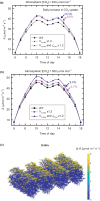Increasing Rubisco as a simple means to enhance photosynthesis and productivity now without lowering nitrogen use efficiency
- PMID: 39688507
- PMCID: PMC11711929
- DOI: 10.1111/nph.20298
Increasing Rubisco as a simple means to enhance photosynthesis and productivity now without lowering nitrogen use efficiency
Abstract
Global demand for food may rise by 60% mid-century. A central challenge is to meet this need using less land in a changing climate. Nearly all crop carbon is assimilated through Rubisco, which is catalytically slow, reactive with oxygen, and a major component of leaf nitrogen. Developing more efficient forms of Rubisco, or engineering CO2 concentrating mechanisms into C3 crops to competitively repress oxygenation, are major endeavors, which could hugely increase photosynthetic productivity (≥ 60%). New technologies are bringing this closer, but improvements remain in the discovery phase and have not been reduced to practice. A simpler shorter-term strategy that could fill this time gap, but with smaller productivity increases (c. 10%) is to increase leaf Rubisco content. This has been demonstrated in initial field trials, improving the productivity of C3 and C4 crops. Combining three-dimensional leaf canopies with metabolic models infers that a 20% increase in Rubisco increases canopy photosynthesis by 14% in sugarcane (C4) and 9% in soybean (C3). This is consistent with observed productivity increases in rice, maize, sorghum and sugarcane. Upregulation of Rubisco is calculated not to require more nitrogen per unit yield and although achieved transgenically to date, might be achieved using gene editing to produce transgene-free gain of function mutations or using breeding.
Keywords: C3 photosynthesis; C4 photosynthesis; Rubisco; food security; future‐proofing agriculture; global change; nitrogen use efficiency; rising CO2.
© 2024 The Author(s). New Phytologist © 2024 New Phytologist Foundation.
Conflict of interest statement
None declared.
Figures




Similar articles
-
Adapting C4 photosynthesis to atmospheric change and increasing productivity by elevating Rubisco content in sorghum and sugarcane.Proc Natl Acad Sci U S A. 2025 Feb 25;122(8):e2419943122. doi: 10.1073/pnas.2419943122. Epub 2025 Feb 11. Proc Natl Acad Sci U S A. 2025. PMID: 39932987 Free PMC article.
-
One crop breeding cycle from starvation? How engineering crop photosynthesis for rising CO2 and temperature could be one important route to alleviation.Proc Biol Sci. 2016 Mar 16;283(1826):20152578. doi: 10.1098/rspb.2015.2578. Proc Biol Sci. 2016. PMID: 26962136 Free PMC article. Review.
-
Improving photosynthesis through the enhancement of Rubisco carboxylation capacity.Biochem Soc Trans. 2021 Nov 1;49(5):2007-2019. doi: 10.1042/BST20201056. Biochem Soc Trans. 2021. PMID: 34623388 Review.
-
Prospects for improving CO2 fixation in C3-crops through understanding C4-Rubisco biogenesis and catalytic diversity.Curr Opin Plant Biol. 2016 Jun;31:135-42. doi: 10.1016/j.pbi.2016.04.002. Epub 2016 Apr 27. Curr Opin Plant Biol. 2016. PMID: 27131319 Review.
-
Acclimation of Photosynthesis to CO2 Increases Ecosystem Carbon Storage due to Leaf Nitrogen Savings.Glob Chang Biol. 2024 Nov;30(11):e17558. doi: 10.1111/gcb.17558. Glob Chang Biol. 2024. PMID: 39487664
Cited by
-
Addition of longer wavelength absorbing chlorophylls into crops could increase their photosynthetic productivity by 26.Nat Commun. 2025 Aug 26;16(1):7933. doi: 10.1038/s41467-025-62885-6. Nat Commun. 2025. PMID: 40858591 Free PMC article.
-
Functional relocation of the maize chloroplast atpB gene to the nucleus restores photosynthetic competence to a gene-edited non-photosynthetic mutant.Plant Biotechnol J. 2025 Sep;23(9):3510-3523. doi: 10.1111/pbi.70175. Epub 2025 Jun 4. Plant Biotechnol J. 2025. PMID: 40467523 Free PMC article.
-
Needs and opportunities to future-proof crops and the use of crop systems to mitigate atmospheric change.Philos Trans R Soc Lond B Biol Sci. 2025 May 29;380(1927):20240229. doi: 10.1098/rstb.2024.0229. Epub 2025 May 29. Philos Trans R Soc Lond B Biol Sci. 2025. PMID: 40439295 Free PMC article. Review.
-
Effects and mechanisms of phytohormones in enhancing the resistance of Oocystis borgei to high ammonium nitrogen stress.Sci Rep. 2025 Jul 9;15(1):24604. doi: 10.1038/s41598-025-10398-z. Sci Rep. 2025. PMID: 40634668 Free PMC article.
References
-
- Aigner H, Wilson RH, Bracher A, Calisse L, Bhat JY, Hartl FU, Hayer‐Hartl M. 2017. Plant RuBisCo assembly in E. coli with five chloroplast chaperones including BSD2. Science 358: 1272. - PubMed
-
- Ainsworth EA, Long SP. 2005. What have we learned from 15 years of free‐air CO2 enrichment (FACE)? A meta‐analytic review of the responses of photosynthesis, canopy. New Phytologist 165: 351–371. - PubMed
-
- Ainsworth EA, Long SP. 2020. 30 years of free‐air carbon dioxide enrichment (FACE): what have we learned about future crop productivity and its potential for adaptation? Global Change Biology 26: 27–49. - PubMed
-
- Ainsworth EA, Serbin SP, Skoneczka JA, Townsend PA. 2014. Using leaf optical properties to detect ozone effects on foliar biochemistry. Photosynthesis Research 119: 65–76. - PubMed
Publication types
MeSH terms
Substances
Grants and funding
LinkOut - more resources
Full Text Sources
Miscellaneous

